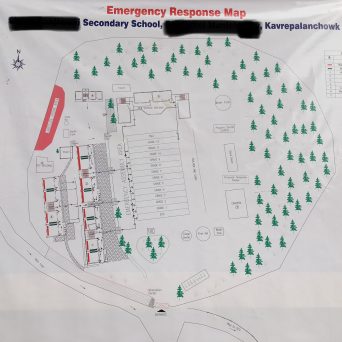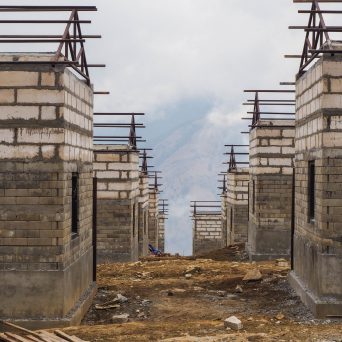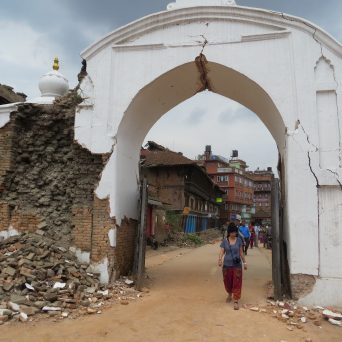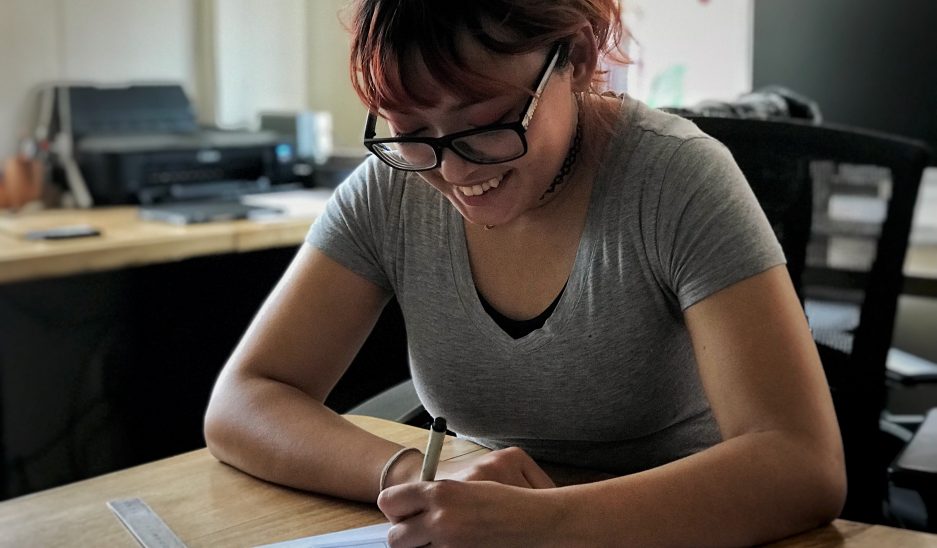
Creating ‘Under the Skin’, a research comic on post-earthquake Tattoo art
1. How the idea for ‘Under the skin’ came about
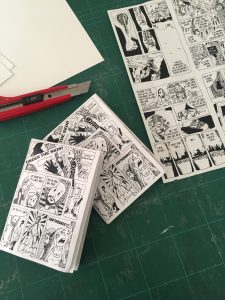
Image M. Bajracharya
Recently, visual story-telling through ‘research comics’ has become popular in academia (see ERC funded project) where otherwise rather convoluted 7000 word journal articles are the norm. Research comics hold the promise of reaching new audiences and effectively communicating applied research with relevance to a wider public. One such excellent research comic, based on research by Gemma Sou and Felix Aponte-Gonzalez, is ‘After Maria’ which discusses the aftermath of Hurricane Maria.
After the earthquake in Nepal the graphic novel format has been explored by NGOs and INGOs. ‘Hamro Avaj’, produced by Unicef and the youth led NGO Yuwalaya, for example, discusses waterborne diseases after the earthquake while ‘Sapana’, was conceptualised by ‘Her Turn’ in collaboration with Oxfam, Women for Human Rights and People in Need to discuss child marriage. Aside from projects which aim to effect behavioural change and risk reduction, two artistic takes on earthquakes in Nepal have resulted in graphic novels. Rishi Amatya and Prakash Ranjit wrote the graphic novel ‘Lumanka Ti’ on the 1255 earthquake in Nepal, and Mrigaja Bajracharya (@mrigajab) wrote ‘Adventures of a Soul’, a Manga exploring life after death in the 2015 earthquake.
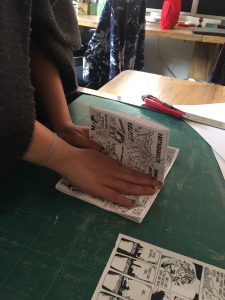
Image M. Bajracharya
When we explored the idea of conveying SWAY research findings in a different medium, we settled on the format of ‘zines’, short handmade folded 8 page comic strips.
This, rather than the longer graphic novel format or the community engagement model used by Unicef and Yuwalaya, attracted our attention—especially after we learned that a full graphic novel could cost as much as £ 20 000 to produce.
Zines, on the other hand, had an attractively low development cost of approximately £200 and an equally low production cost of mere cents that would allow us to simply distribute the comic for free. We have no intention to claim copyright over the final product and any ordinary copy shop can reprint copies on demand.
Once printed the zine has to be cut across the two middle pages and folded
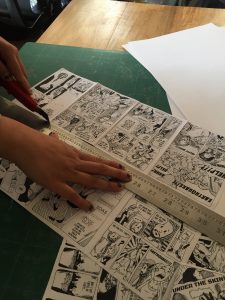
Image M. Bajracharya
Initially, SWAY planned a collection of zines on different aspects of our research – here we are able to introduce the first of these: a zine on post-earthquake Tattoo art entitled ‘Under the Skin’.
Zines are a somewhat challenging format. There is no space for a complex narrative, so it is the visuals which have to convey emotional depth as well as ambivalence. During my research on post-earthquake tattoos I encountered both tattoo artists who were tired of inking yet another image of the Dharahara tower as well as clients who had inked their entire biographies on skin, and then marked the 2015 earthquake in an act of commemoration with a further tattoo.
It is not perhaps not surprising that a collectively experienced natural disaster can be read visually through the collection of individual tattoos. What is exceptional and worthy of research is the fact that most post-earthquake tattoos in Nepal speak of the lost heritage buildings that fell down during the earthquake. Traditionally, the Newars believe that in order to transition into the next life one must pay for one’s passage. Unable to take anything with us after death, it is believed that one’s tattoos can be sold on the way. When I met Mrigaja Bajracharya and read her dystopian post-earthquake Manga, it was immediately obvious to me that she would be the ideal person to engage with in a zine project on post-earthquake tattoos. After we had discussed my research and looked at the visual documentation of post-earthquake tattoos, Mrigaja created the fictional character of Arbin and a general story board which we jointly fine-tuned to tell a story of the aftermath.
2. Read ‘Under the skin’
3. In the following Mrigaja Bajracharya (artist) speaks to Stefanie Lotter (researcher) about the making of ‘Under the skin’
How did you become a comic book artist?
I loved cartoons, I read any comic book I could get my hands on, and I fell in love with Mangas when I found that my uncle had a stack of them. I was probably 11 when I started reading and I have not stopped yet. Kathmandu’s Manga and Anime scene is growing. For the last 5 or 6 years, we have had Comicon events including comic book competitions and cosplay. For example, ‘Demon’ developed from a Comicon competition winner into a published graphic novel. So Comicon events are essential for the emerging field of Nepali graphic novels.
I started drawing comics when I was in grade 11 and shared my series with friends during lessons. It basically kept us from falling asleep in class. After I finished school, I went to the Centre of Art and Design at the School of Arts at Kathmandu University. I was really not into sculpture but I loved the illustration classes, and even more the graphic novel collection at the University Library. For my graduation assignment I decided to do a comic book. I collected various real life stories from my friends to create a story board, but then the earthquake happened.
Experiencing the earthquake was devastating. I still remember the second day, when the aftershocks calmed down a little and I went out with my uncle in his van. We went over to Kathmandu to see the damage for ourselves. It was shocking to see all the heritage sites destroyed, and it felt as if one part of our history would never be there again. In Nepali culture there are many stories of ghosts, in particular those ghosts of people who died a premature death. I started wondering what had happened to all the people who died in the earthquake. Were these ghosts of the dead still around, living between us?
In the months after the earthquake, I started developing a story board around these ghosts and later this became my final year project at Uni. I named the graphic novel ‘The Adventures of the Soul’, it was later published by Book Art Nepal. The novel tells the story of Arishma who dies in the earthquake and takes some time to realise that she has become a ghost. Life as a ghost is hard and Arishma sees her boyfriend falling in love with another woman. The story ends with Arishma’s ghost friend Nina being reborn as the child of Arishma’s former boyfriend and his new wife.
There is one more graphic novel on the topic of earthquakes, it is called ‘Lumankati’. Rishi Amatya and Prakash Ranjit collaborated on this one. Lumankati tells the history of the 1255 earthquake in Nepal.
Before you started on our joint zine project, you had to read my research paper on post-earthquake tattoos. How did you find it?
Yes, you sent me a copy of the article draft and I liked it. You see, I always wanted to become a tattoo artist myself at some point in my career, but I have not quite got around to doing that yet. So the topic already interested me and the research actually gave me an interesting insight into the Kathmandu tattoo scene.
What does it mean to transform research findings into a comic strip?
It certainly was the first time I had turned research into a comic strip and I liked the challenge. It was enormously difficult to reduce the complexity of the research into an 8-page comic book. We discussed this a lot and decided that we wanted to convey the emotional impact of the earthquake that motivated clients to have post-earthquake tattoos. At the same time, we wanted to show the impact of the earthquake on the tattoo artists, the studios and their artistic work.
After all, the earthquake took place on the second day of the Tattoo Convention, a big event at the Yak and Yeti hotel where hundreds of local and international artists had come together to showcase their work. You (Stefanie) also shared the images of post-earthquake tattoos with me, and I was surprised to see so many Dharaharas inked on skin and other tattoos that depicted the destruction of the city and its heritage.
Arbin, the main character of our zine, was fun to create. We wanted him to look like a stereotypical tattoo artist with a hippie dreadlock look. He had to look young and we wanted his skin to be covered in tattoos. I have seen photos of famous tattoo artists from Nepal – they just look like the coolest people in the world. The story starts off with Arbin encountering a young woman who admires his work at the convention. Then the earthquake strikes and they get separated. It is only at the end of the comic strip, a year after the earthquake, that the young woman returns to finally get her first tattoo. She chooses one of the most common post-earthquake tattoos, a Dharahara, which Arbin does not find very inspiring but rather exhausting, because he has inked so many of them. The placement and size of the tattoo is a bold statement, however. When she looks into the mirror in the last frame of the comic, the young woman is delighted with Arbin’s work.
Do you make sketches on paper or do you immediately draw on the computer?
Usually I start by sketching out the story board. Then I enlarge the size and work on an A4 sheet, even though the final work will be in A6. This makes it more detailed. I like drawing with a soft pencil and in the second stage I move to a variety of ink pens. After that, I scan my work and do a digital touch up in Photoshop. The text is then inserted manually into each speech bubble – which means that I can do many different languages if necessary. For ‘Under the Skin’ we wanted English and Nepali. I have recently also drawn a comic entirely on Photoshop based on only a rough pencil draft. It is actually not all that different from drawing on paper. I got myself a new ipad and the whole digital drawing process has become really easy.
Did working on the zine project bring up memories of the earthquake?
When I drew the zine, I tried to embody the main character Arbin and see what happened through his eyes. This was not easy as it was bringing up my own memories of the earthquake. It brought back how it felt at the instant of the earthquake. The moment when after the first short jolt of the earthquake wave it simply did not stop but went on for what felt like a very long time. After the earthquake the first thing you think is: what has happened to the family members that are not with you? This is what I remember feeling and it is also what we depicted in the comic. Arbin immediately picks up the phone to call his mother, and so does everyone else in the comic. We all did the same thing at home.
I remember that the shop next door to our house was closed when the earthquake happened because it was a Saturday. Immediately after the earthquake we all came out of our houses and the shopkeeper came too, opened his shop and while everything in the shop had fallen from the shelves, he immediately searched for the phone recharge cards that everyone now needed to call their family and friends. When I sketched the comic, these incidents came back to me as I sat there, pencil in hand.
Do you find it surprising that Nepalis ink images of heritage sites on their skin?
Thinking this over and not knowing that there were so many heritage tattoos being inked, I am still somewhat surprised. However, it seems almost logical to keep heritage sites alive on the skin while they are broken and are no longer there. I think that heritage tattoos are a lot like commemorative tattoos of family members who have passed away. It is like the tattoos that people make of their mum or dad to keep them close. With heritage tattoos we want to keep memories and our history close to us.

